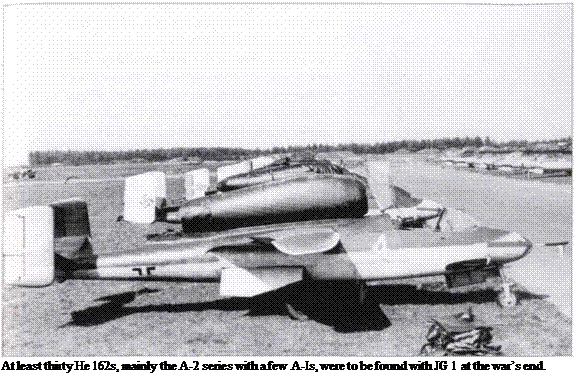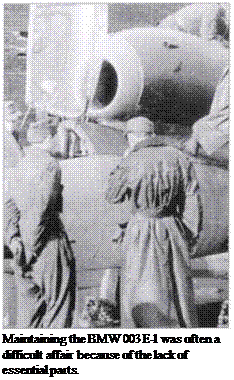Conversion Training of JG 1 Oesau
By the OKL decision, JG 1, recendy tested in the fighting on the Eastern Front, became the standard bearer for the new aircraft. Stabsstaffel/JG 1 would take over the tactical trials and training and would therefore be direcdy accountable to KdE. On 11 February the Stabsstaffel was placed under the jurisdiction of KdE by order of the Luftwaffe organisation staff. According to the plans, I./JG 1 was to be brought up to strength by personnel from II. and III./JG 1. At the same time Luftkommando 6 telexed I./JG 1 that the unit was now deemed to be resting and all its Fw 190s were to be handed over to II./JG l. The latter was also to send its own advance party to Vienna Aspern for the later transfer there of the He 162. Nothing came of this because the end was so near. The entire Geschwader, however, was to prepare itself immediately for the Volksjager on orders of OKL.
On 25 January the situation of JG 1 did not look favourable. I./fG 1 had 13 Fw 190 A-8 and A-9 aircraft return from the Eastern Front under Oberleutnant Demuth. A little later the remaining aircraft of II./JG 1 followed. III./JG 1 existed only on paper. During the retreat before the Soviet advance in East Prussia, the unit had been almost completely wiped out. Until the beginning of February the remaining Fw 190s were used as Jabos before II./JG 1 transferred to Rostock-Marienehe. The Red Army was then engaged from the Heinkel Works airfield. While this was in progress, on 9 February I./fG 1 support section arrived at Parchim. The remnants of both Gruppen would now form two Auffangsstaffeln (‘intercept squadrons’) on the He 162, these being l./JG 1 at Marienehe and Bernburg, and 2./JG 1 at Heidfeld/Vienna.
On 24 February, 2. Staffel led by Leutnant Hachtel transferred to Heidfeld, and two days later OKL ordered III./JG 1 to Parchim immediately. As there were no He 162s available there, most of the Staffel went to Vienna instead, where for some time He 162 M-19 had been the only machine ready for use by JG 1, provisionally as a trainer. As no other He 162s were expected immediately, parts of II. and III./JG 1 returned to Parchim. Instruction using one machine at Vienna was a lengthy business, and by 7 March only eight pilots of I./JG 1 had been conversion-trained for the Volksjager. A number of flight restrictions were in force: in particular it was forbidden to exceed 500 km/hr (310 mph) for longer
than 15 minutes on account of the susceptibility of the BMW turbines to breakdown. The situation was no better at Heidfeld because there were insufficient ground staff trained for the He 162.
In central Germany the ubiquitous shortages ensured that He 162 production advanced only slowly. There were too few skilled personnel and technical staff to service the Volksjager, since most trained servicemen were at the front. It was not possible to call upon Heinkel staff or their flight trials organisation because it had long been overburdened with work. The shortage of В-4 (benzine) cut back flying time. The conversion of BMW 003 turbines to J-2 (kerosene) had proved far more difficult than expected and could not be implemented for the time being. The combination of all these problems was destroying any hope that the Volksjager would be able to change the course of the air war over the Reich in the foreseeable future. Only Hitler and a few of the Luftwaffe commanders in their bunkers thought it possible to introduce positive changes fast. The ever more hasty forward planning reaching the Geschwader from March onwards took no account of the everyday major technical problems and ever worsening difficulty of fuel supply.
The reorganisation of JG 1, at least on paper, was on hand at QM-General level. Besides the 16 He 162s with the Stabstaffel, three Gruppen of 52 Volksjager each were projected for May 1945, a plan beyond the scope of reality. The QM – General could distribute his aircraft as he saw fit, but before they arrived they would often fall foul of Allied fighters or bombing raids. Equally, some very mundane reason might prevent completion of aircraft: a piece of equipment might not be delivered because of production hold-ups, although most often it would be shortage of fuel or a turbine problem, perhaps because a spanner had literally been dropped in the works by a forced labour saboteur. When the turbine was test-run it would be ruined, and it would be necessary to wait for a replacement. A repair would often not be possible for insufficient spare parts.
QM-General would not be deterred and ordered series aircraft 1-5 to Heidfeld, 6-13 were to be held back for tactical trials at Lechfeld, 14-20 were planned for tactical trials at Roggenthin/Rechlin. In fact no machines had ever been available for flying trials. Auffangsstaffel 2./JG 1 for example had still received no He 162s by 21 March.
On 26 March all the scheduling was revised. The first 18 series machines were to go to Heidfeld. Only afterwards would the tactical and operational trials begin. Nevertheless by 30 March no He 162s had yet landed at either Lechfeld or Rechlin. The first two machines, ЕЗФ51 and ЕЗФ52 finally arrived at Rechlin in mid-April. The emergency trials programme ended a few days later, not on account of the Allied advance but for organisational reasons.
Meanwhile the development and production of all kinds of aircraft had undergone an ominous change on 26 March when Hitler gave SS-General
 |
Kammler wide-ranging plenipotentiary powers. All powers relating to jet aircraft invested hitherto in Reich Minister Speer passed to the SS, while Hitler also subordinated Goring’s General Plenipotentiary for Jet Aircraft to Kammler for the speedy execution of the portfolio. While Kammler familiarised himself with his new area of jurisdiction, the provisional instructions for the production and flying of the He 162 remained in force.
The Soviet advance to the gates of Vienna had led Heinkel-Siid to recognise that the airfields and production facilities in the Vienna region would only remain available for a short period. In secret they began removing files and equipment to the west. As far as possible completed machines were brought to safety at Langenlebarn west of Vienna. From there the majority of pilots took their Volksjager to Horsching/Linz. Here a number of non-airworthy Volksjager remained behind because there were no maintenance facilities for jets. The others were flown to Munich-Riem and Lechfeld. During this operation on 31 March Heinkel works pilot Huldreich Kemnitz crashed during the transfer flight and lost his life. At Lechfeld an attempt to begin operational training was abortive. Only a few test flights were undertaken there before it became necessary to head east for Munich as US ground forces came up.
At the beginning of April the opposing ground forces, German and Russian, clashed before Vienna. By 5 April it was obvious that the front would not hold. Russian tanks rolled into the heart of Vienna and crushed the last resistance of the SS and Hitler Jugend. Flight trials had long been forgotten. Gradually all airfields around Vienna fell into Russian hands. The last death in testing the He 162 occurred on 6 April 1945 when works pilot Wolfgang Liiddemann crashed. Schwechat (Heidfeld) airfield was being abandoned and Liiddemann attempted to fly out with the last airworthy Volksjager and failed.
 Meanwhile Kammler had involved himself in the development and production of the Ar 234 and He 162 jets and ordered that all manufacturing of piston-engined aircraft was to cease while the production of the He 162 was to be greatly accelerated. The instruction was expressed in similar terms in an OKL telex of 4 April 1945:
Meanwhile Kammler had involved himself in the development and production of the Ar 234 and He 162 jets and ordered that all manufacturing of piston-engined aircraft was to cease while the production of the He 162 was to be greatly accelerated. The instruction was expressed in similar terms in an OKL telex of 4 April 1945:
Continuing with the He 162 means persevering with an aircraft which deserves acceptance having regard to its stage of testing – in short a good modern fighter aircraft, if with little flying time, whose final cost is substantially less than for Me 262 and which makes lesser demands on the ground organisation. Moreover, it is expected that this aircraft will bring successes in the battle against the oppressive fighter-bomber plague.
General Karl Roller, Chief of the Luftwaffe General Staff, asked Kammler on 4 April to reconsider his decision regarding the He 162. Whether the SS – General, who had struck out nearly all Hitler’s newest air armaments with a stroke of the pen, answered or not is not recorded. Whatever was said at the top, conversion training at JG 1 went on to the extent that it was possible.










